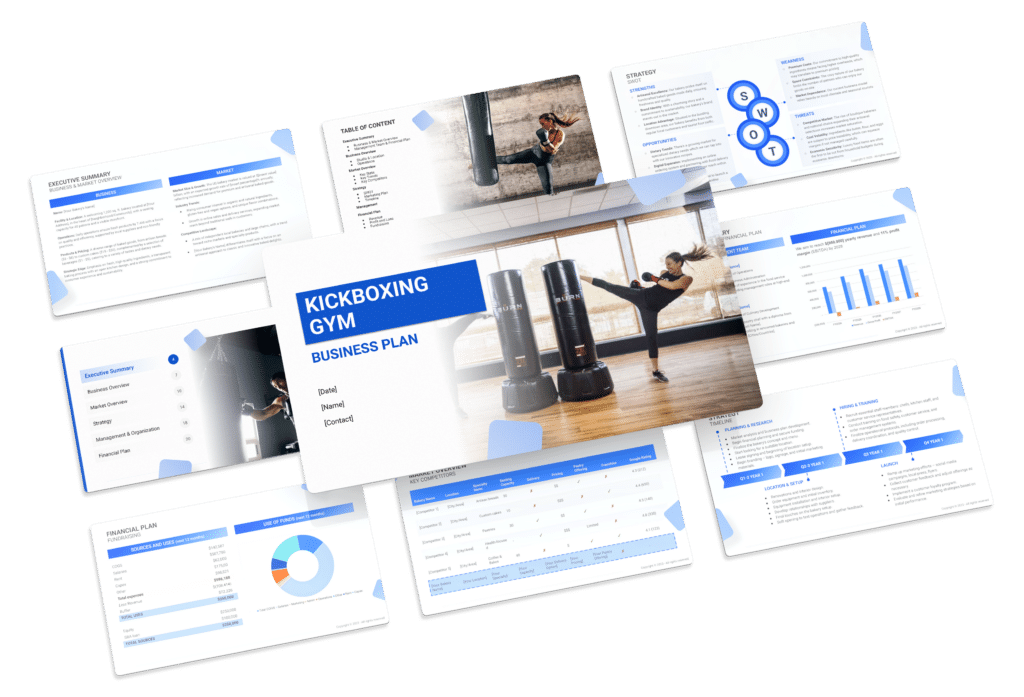Sales & Marketing Plan for a Kickboxing Gym

Running a thriving kickboxing gym requires more than just offering high-quality training sessions; it also necessitates an effective approach to marketing and sales.
This comprehensive guide is tailored to help you develop a robust sales and marketing plan designed specifically for the business plan of a kickboxing gym.
We’ll start by delving into an analysis of your market, enabling a comprehensive understanding of your competitors and your potential customers’ needs. Subsequently, our focus will shift towards building your gym’s brand and strategically positioning it in the market.
Then, we’ll explore diverse marketing channels to facilitate reaching your target audience, finishing in an exploration of various sales strategies to augment your gym’s revenue.
Market Analysis
Understanding the market landscape is crucial for positioning your kickboxing gym strategically.
Competitive Analysis
- Identify Competitors: Research other kickboxing gyms nearby. Analyze their training programs, pricing structures, client reviews, and marketing strategies to discern their strengths and weaknesses.
- SWOT Analysis: Conduct a SWOT analysis (Strengths, Weaknesses, Opportunities, Threats) for your gym in comparison to competitors. It involves internal analysis (strengths and weaknesses) and external factors (opportunities and threats), enabling you to identify areas for improvement and opportunities for differentiation.
Target Audience Profiling
- Demographic Insights: Define the age range, gender distribution, income levels, fitness preferences, and training goals of your ideal kickboxing clientele. Consider conducting surveys or using customer relationship management (CRM) tools to gather essential demographic data.
- Psychographic Details: Understanding their interests, fitness aspirations, and specific kickboxing preferences is equally essential. Analyze their motivations behind joining a kickboxing gym, whether it’s weight loss, stress relief, learning self-defense, or overall fitness.
Branding and Positioning
Establishing a strong brand identity sets the tone for your gym’s success.
Brand Identity Development
- Gym Narrative: Share your gym’s vision and values. What inspired the establishment of your kickboxing gym? What unique training perspectives do you offer? Create a compelling narrative that resonates with potential members, expressing your commitment to fitness, discipline, and overall well-being.
- Visual Identity: Develop a cohesive visual identity, including logos, color schemes, and gym ambiance, reflecting your brand and resonating with your target audience. Ensure consistency across all touchpoints, from your website and social media to physical gym spaces.
Defining Your Gym’s Unique Proposition
- Articulate Unique Offerings: Highlight specialized training techniques, exceptional trainers, wellness workshops, or a motivating gym atmosphere. Emphasize the elements that set your gym apart from others in the market. Positioning Statement: Craft a concise statement encapsulating your gym’s essence and guiding your marketing strategies. This statement should resonate with your target audience while effectively differentiating your gym from competitors.
Marketing Channels
Engage your audience through various marketing avenues to enhance brand visibility and attract clients.
Digital Marketing
- Utilize Social Media: Leverage platforms like Instagram for workout snapshots, behind-the-scenes content, and member success stories. Share motivational posts, training tips, and videos on Facebook, highlighting trainers’ expertise and members’ achievements. Utilize YouTube for instructional videos, workouts, and live streams, engaging your audience with diverse content.
- Email Marketing: Build an email list offering exclusive content and special training packages. Craft engaging newsletters featuring success stories, member spotlights, and upcoming events. Use personalized content to increase engagement and drive membership sign-ups.
- SEO and Website Development: Create a user-friendly website featuring class schedules, trainer profiles, and blog posts on kickboxing and fitness. Optimize for local SEO to increase online visibility.
Local Promotion and Community Engagement
- Offline Advertising: Distribute informative flyers in local fitness centers and cafes. Place ads in community magazines or newspapers.
- Community Events: Organize free kickboxing sessions in parks or participate in fitness expos, offering trial classes or consultations to connect with potential clients.
- Collaborations: Partner with local health stores or gyms for mutual promotions or combined events.
Promotional Strategies
- Membership Offers: Introduce various membership plans like unlimited sessions, family packages, or trial periods tailored to diverse client needs.
- Loyalty Programs: Implement rewards, such as free workshops or merchandise, after a certain number of classes, enhancing customer retention.
- Referral Programs: Incentivize existing members to refer new clients by offering discounts or special classes as rewards.
Sales Channels
Efficient sales channels are pivotal for boosting revenue and ensuring client satisfaction.
In-Gym Sales Techniques
- Additional Services: Offer workshops, private sessions, or advanced classes to enrich the client experience and increase revenue.
- Retail Products: Retail kickboxing equipment, merchandise, and fitness products in your gym to complement clients’ training routines and generate additional income.
- Package Bundles: Create packaged deals that combine training sessions with additional benefits. Offer package deals like ‘Kickboxing Essentials’ that include gloves, wraps, and a water bottle, or ‘Fitness Starter Kits’ containing resistance bands, jump ropes, and sweat towels. Bundling these items can enhance the training experience and generate supplementary revenue.
Online Booking and Membership Sales
- Streamlined Booking: Implement a user-friendly online booking system through your website or app, providing incentives like discounts for online bookings.
- E-Commerce: Sell branded gear, accessories, and gift cards online, broadening your customer reach and sales opportunities.
- Virtual Services: Offer online training sessions or consultations for personalized fitness advice, fostering tailored service bookings and product recommendations.
Membership and Loyalty Programs
- Diverse Membership Options: Introduce membership tiers with added perks like discounts on workshops, guest passes, or exclusive events.
- Loyalty Rewards: Develop digital loyalty programs where clients earn points per session, redeemable for discounts or free classes, encouraging client loyalty.



